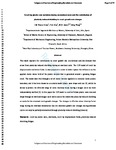Crack tip plastic zone evolution during an overload cycle and the contribution of plasticity-induced shielding to crack growth rate changes
| dc.contributor.author | Vasco-Olmo, JM | |
| dc.contributor.author | Díaz, FA | |
| dc.contributor.author | James, Neil | |
| dc.contributor.author | Yang, B | |
| dc.date.accessioned | 2018-10-17T16:07:50Z | |
| dc.date.available | 2018-10-17T16:07:50Z | |
| dc.date.issued | 2018-09-06 | |
| dc.identifier.issn | 8756-758X | |
| dc.identifier.issn | 1460-2695 | |
| dc.identifier.uri | http://hdl.handle.net/10026.1/12577 | |
| dc.description.abstract |
This work explores the contribution to crack growth rate acceleration and deceleration that arises from plasticity-induced shielding during an overload cycle. The CJP model of crack tip displacements and stress fields was proposed to better capture the influences on the applied elastic stress field of the plastic enclave that is generated around a growing fatigue crack. The model does this through a set of elastic stresses applied at a notional elastic-plastic boundary, and it has been shown to accurately model plastic zone shape and size, whilst its ability to predict the effective range of stress intensity factor during a fatigue cycle has been independently verified. In this paper, the CJP model is used to follow plastic zone size and shape through an overload fatigue cycle and to assess the extent that plasticity-induced shielding accounts for the observed crack growth changes. The changes in effective stress intensity factor range during the overload demonstrate that the observed growth rate changes during overload cycles can only be partially rationalised through plasticity-induced shielding (closure). | |
| dc.format.extent | 2172-2186 | |
| dc.language | en | |
| dc.language.iso | en | |
| dc.publisher | Wiley | |
| dc.subject | crack tip displacement fields | |
| dc.subject | crack tip plastic zone | |
| dc.subject | fatigue | |
| dc.subject | overloads | |
| dc.subject | plasticity-induced shielding | |
| dc.title | Crack tip plastic zone evolution during an overload cycle and the contribution of plasticity-induced shielding to crack growth rate changes | |
| dc.type | journal-article | |
| dc.type | Journal Article | |
| plymouth.author-url | https://www.webofscience.com/api/gateway?GWVersion=2&SrcApp=PARTNER_APP&SrcAuth=LinksAMR&KeyUT=WOS:000443939300009&DestLinkType=FullRecord&DestApp=ALL_WOS&UsrCustomerID=11bb513d99f797142bcfeffcc58ea008 | |
| plymouth.issue | 10 | |
| plymouth.volume | 41 | |
| plymouth.publication-status | Published | |
| plymouth.journal | Fatigue and Fracture of Engineering Materials and Structures | |
| dc.identifier.doi | 10.1111/ffe.12840 | |
| plymouth.organisational-group | /Plymouth | |
| plymouth.organisational-group | /Plymouth/Faculty of Science and Engineering | |
| plymouth.organisational-group | /Plymouth/Faculty of Science and Engineering/School of Engineering, Computing and Mathematics | |
| plymouth.organisational-group | /Plymouth/Users by role | |
| plymouth.organisational-group | /Plymouth/Users by role/Academics | |
| dcterms.dateAccepted | 2018-04-12 | |
| dc.rights.embargodate | 2019-6-6 | |
| dc.identifier.eissn | 1460-2695 | |
| dc.rights.embargoperiod | Not known | |
| rioxxterms.versionofrecord | 10.1111/ffe.12840 | |
| rioxxterms.licenseref.uri | http://www.rioxx.net/licenses/all-rights-reserved | |
| rioxxterms.licenseref.startdate | 2018-09-06 | |
| rioxxterms.type | Journal Article/Review |


